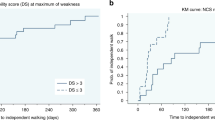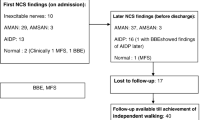Abstract
Introduction
Twenty percent of patients with Guillain-Barré syndrome (GBS) have poor outcomes despite proper management. The aim of the study was to characterize electrophysiological factors related to poor outcome in patients with GBS.
Methods
We conducted an observational study from a prospective cohort of 91 patients with GBS in a tertiary healthcare center in Mexico, from 2017 to 2019. Demographics and nerve conduction studies were performed on admission, and a 3-month follow-up for GBS disability score was ensued, allocating patients in good (GBS disability score ≤ 2) and poor outcome (GBS disability score ≥ 3) groups. A logistic regression analysis for independent walk at 3 months was performed. Kaplan–Meier estimator curves for independent walk in very low (< 20% LLN) and low-normal ( ≥20% LLN) peroneal nerve CMAPs are presented.
Results
From the 91 GBS patients included, 37 (40.6%) did not regain independent walk at 3 months. Axonal variants were more common in the poor outcome group (31.4% vs 59.4%, p = 0.01) as well as AIDP variants with motor conduction block (6.6% vs 42.4%, p = 0.018). Univariable analysis was statistically significant for very low median, ulnar, tibial, and peroneal CMAP amplitudes in poor outcome patients; however, multivariable analysis was only significant for very low peroneal nerve CMAP amplitude (OR 3.6 [1.1–11.5, p = 0.024]). Conversely, a greater proportion of GBS patients with low-normal CMAPs recovered independent walk at 90 days (75% vs 30%, p < 0.001).
Conclusion
Severe axonal injury of the peroneal nerve, axonal, and AIDP with motor conduction block variants predicts worse functional outcome regarding independent walk at 3 months.

Similar content being viewed by others
References
Sejvar J, Baughman A, Wise M et al (2011) Population incidence of Guillain- Barré syndrome: a systematic review and meta- analysis. Neuroepidemiology 36:123–133
van den Berg B, Walgaard C, Drenthen J et al (2014) Guillain-Barré syndrome: pathogenesis, diagnosis, treatment, and prognosis. Nat Rev Neurol 10(8):469–482
Chio A et al (2003) Guillain-Barré syndrome: a prospective, population-based incidence and outcome survey. Neurology 60:1146–1150
van Koningsveld R et al (2007) A clinical prognostic scoring system for Guillain– Barré syndrome. Lancet Neurol 6:589–594
Walgaard C, Lingsma HF, Ruts L et al (2011) Early recognition of poor prognosis in Guillain-Barre syndrome. Neurology 76(11):968–975
Hughes RA, Cornblath DR (2005) Guillain Barré syndrome. Lancet 366(9497):1653–1666
Kuwabara S, Yuki N (2013) Axonal Guillain-Barré syndrome: concepts and controversies. Lancet Neurol 12(12):1180–1188
Berciano J. Axonal degeneration in Guillain-Barré syndrome: a reappraisal. J Neurol. 2020. https://doi.org/10.1007/s00415-020-10034-y. Online ahead of print.
Dimachkie MM, Barohn RJ (2013) Guillain-Barré syndrome and variants. Neurol Clin 31(2):491–510
Chan YC, Punzalan-Sotelo AM, Kannan TA et al (2017) Electrodiagnosis of reversible conduction failure in Guillain-Barré syndrome. Muscle Nerve 56(5):919–924
Cornblath DR, Mellits ED, Griffin JW et al (1988) Motor conduction studies in Guillain-Barré syndrome: description and prognostic value. Ann Neurol 23(4):354–359
Uncini A, Kuwabara S (2012) Electrodiagnostic criteria for Guillain-Barré syndrome: a critical revision and the need for an update. Clin Neurophysiol 123(8):1487–1495
Hadden RDM, Cornblath DR, Hughes RAC et al (1998) Electrophysiological classification of Guillain-Barré syndrome: clinical associations and outcome. Ann Neurol 44:780–788
Rajabally YA, Durand M-C, Mitchell J et al (2014) Electrophysiological diagnosis of Guillain-Barré syndrome subtype: could a single study suffice? J Neurol Neurosurg Psychiatry 86(1):115–119
Asbury AK, Cornblath DR (1990) Assessment of current diagnostic criteria for Guillain-Barré syndrome. Ann Neurol 27(Suppl):S21–S24
Butler K, Morris J, Scott K, et al. Neuroanatomy for nerve conduction studies. AANEM Course. 2010. Pp: 1–36
Mallik A, Weir A. Nerve conduction studies: essentials and pitfalls in practice. J Neurol Neurosurg Psychiatry 2005;76(Suppl II):ii23–ii31.
Collins GS, Reitsma JB, Altman DG et al (2015) Transparent reporting of a multivariable prediction model for Individual Prognosis or Diagnosis (TRIPOD): the TRIPOD statement. Ann Intern Med. 162(1):55–63
Hosokawa T, Nakajima H, Unoda K et al (2014) An electrophysiological classification associated with Guillain-Barré syndrome outcomes. J Neurol 261(10):1986–1993. https://doi.org/10.1007/s00415-014-7452-2
Niu J, Liu M, Sun Q et al (2018) Motor nerve conduction block predicting outcome of Guillain-Barre syndrome. Front Neurol 9:399. https://doi.org/10.3389/fneur.2018.00399
Verma R, Chaudhari TS, Raut TP, Garg RK (2013) Clinico-electrophysiological profile and predictors of functional outcome in Guillain-Barre syndrome (GBS). J Neurol Sci 335(1–2):105–111
Uncini A, Manzoli C, Notturno F, Capasso M (2010) Pitfalls in electrodiagnosis of Guillain-Barré syndrome subtypes. J Neurol Neurosurg Psychiatry 81(10):1157–1163. https://doi.org/10.1136/jnnp.2010.208538
Susuki K, Yuki N, Schafer DP et al (2012) Dysfunction of nodes of Ranvier: a mechanism for anti-ganglioside antibody-mediated neuropathies. Exp Neurol 233(1):534–542. https://doi.org/10.1016/j.expneurol.2011.11.039
Kokubun N, Nishibayashi M, Uncini A et al (2010) Conduction block in acute motor axonal neuropathy. Brain 133(10):2897–2908. https://doi.org/10.1093/brain/awq260
Willison HJ, Jacobs BC, van Doorn PA (2016) Guillain-Barré syndrome. Lancet 388(10045):717–727
Kuwabara S, Uncini A (2013) Multiple mechanisms for distal axonal loss in Guillain- Barré syndrome. Clin Neurophysiol 124(4):821–822. https://doi.org/10.1016/j.clinph.2012.08.008
Walgaarr C, Lingsma HFM, Ruts L, van Doorn PA et al (2011) Early recognition of poor prognosis in Guillan-Barre syndrome. Neurology. 76(11):968–75
Rajabally YA, Hiew FL (2017) Optimizing electrodiagnosis for Guillain-Barré syndrome: clues from clinical practice. Muscle Nerve 55(5):748–751. https://doi.org/10.1002/mus.25433
Author information
Authors and Affiliations
Corresponding author
Ethics declarations
Ethical approval and consent to participate
The present article was approved by the Ethics committee.
Conflict of interest
The authors declare that they have no competing interests.
Additional information
Publisher's note
Springer Nature remains neutral with regard to jurisdictional claims in published maps and institutional affiliations.
Rights and permissions
About this article
Cite this article
López-Hernández, J.C., Galnares-Olalde, J.A., Jorge de Saráchaga, A. et al. Very low peroneal nerve compound muscle action potential amplitude predicts poor outcome in patients with Guillain-Barré syndrome: a prospective cohort. Neurol Sci 43, 3923–3928 (2022). https://doi.org/10.1007/s10072-021-05834-7
Received:
Accepted:
Published:
Issue Date:
DOI: https://doi.org/10.1007/s10072-021-05834-7




